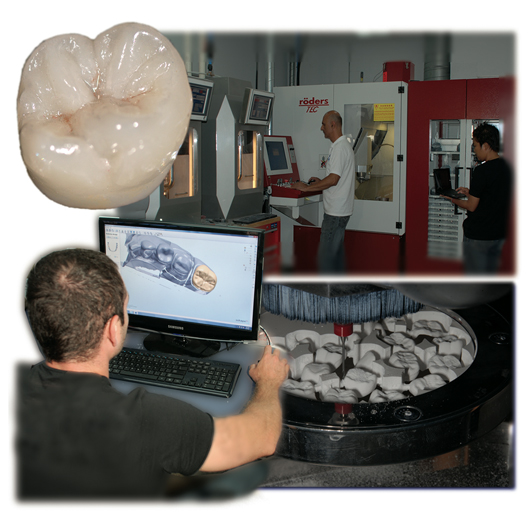Burbank Delivers Speed, Consistency with Advanced Milling Technology
Burbank Dental Laboratory Inc. is known for creating quality customized esthetic restorations. At the lab’s Advanced Technology Center, the state-of-the-art CAD/CAM milling equipment allows the technicians at Burbank to create restorations using the dentist’s exact specifications and tolerances, with a faster turnaround and consistency from case to case. David French, Burbank’s Vice President of Marketing, is enthusiastic about the technology the company currently offers, as well as where that technology will take Burbank in the future.
“The investment that Burbank has made over the past year-and-a-half into CAD/CAM technology is remarkable,” says French, “We are now able to produce in-house what we previously had to depend on large manufacturing and implant companies to produce for us. This gives our doctors more direct control over the final outcome.”
The advanced milling technology allows Burbank to easily work with materials that were previously difficult and laborious to use, such as zirconia and titanium. Andrew Sedler, Director of the Advanced Technology Center at Burbank, elaborates, “Before we had our own in-house milling center, working with these materials was very labor intensive. Now we are able to produce custom milled zirconia restorations with a significantly higher level of accuracy from case to case. Additionally, very soon we will also be able to provide custom milled zirconia and titanium implant abutments with this same equipment.”
Burbank’s extremely durable Zir-MAX®M zirconia is an example of a material that uses CAD/CAM milling to produce these durable, yet translucent, restorations. French explains that Zir-MAX®M restorations, as well as yet-to-be-released implant abutments and bars made from titanium, are products that help to satisfy Burbank’s goal of providing precision and accuracy. “We don’t have to make adjustments for expansion and shrinkage during the waxing and casting process. We can mill the material to the precise depth and measurements of the implant analogs so that the fit of the implant components is within the correct tolerances,” he says.
Burbank’s laboratory is not just able to more accurately and consistently produce restorations, but its new technology is able to accommodate much more precise specifications than laboratories have been able to offer in the past. If a clinician is looking for crowns to fit a certain way or to possess a specific plane of occlusion, technicians are able to program the machinery to mill to those exact specifications.
“The precision of our technology offers accuracy in measurements as small as .5 microns, depending on the application,” says French. Sedler adds that the laboratory machinery is also capable of providing different styles of anatomy, and the machines can be programmed to provide clinicians with restorations and crowns that meet the needs of their personal preferences.
The CAD/CAM technology offered in Burbank’s lab also allows the company to eliminate certain steps in the production process, saving clinicians chair time while still being able to produce high-quality restorations. “We are able to go directly from intraoral digital impression to designing and milling. We can finish the restorations and have the case back to the clinician without having to ever take impressions, fabricate models, or do any castings,” says Sedler.
Among Burbank’s digital tools is the Cadent iTero™ Digital Impression System. Designed to replace traditional impressions, the iTero system offers clinicians and laboratories a technology-driven, highly efficient impression procedure.
New technology is also changing the way Burbank operates its business. The rise of e-communication, like e-mail and video chat, allows clinicians and lab technicians to communicate regarding their cases instantaneously. “There is a much faster turnaround time,” says French. “Since we are able to use digital input from clinicians, we do not need to wait for impressions or models to reach the lab, and sometimes we can have a completed restoration ready as soon as the day after the prep appointment.” French believes that the ability to better communicate with clinicians ultimately results in better restorations and better results for the patients.
French is proud not only of Burbank’s ability to cater to its clients, but also the company’s capacity to make custom-made restorations more affordable. “We can now make all of our components patient-specific and offer them at an attainable price,” says French.
Currently, Burbank is seeking to marry its technological prowess to its educational endeavors by combining the company’s education and technology centers. Burbank’s facility allows for hands-on courses, lectures, and study clubs, while serving as a launching platform to provide webinars. The company aims to use its technology to educate clinicians in tandem with the lab work already being performed. “We feel that if people don’t know how to use the technology, the technology becomes a moot point. We have to recognize that education and evolution are the cornerstones of this era of dentistry, and they are going to hold our next generation of dental professionals together,” says French.
“Even though we are using technology to assist in the fabrication of our excellent restorations, we recognize the need to enhance our human interaction with our clients,” adds French. “This is why we have a personal ‘concierge’ team of customer service and technical support that clients will deal with upon every contact with Burbank. Clients can call and speak with a personal technical advisor to discuss their personal preferences.”
Burbank Dental Laboratory Inc.
2101 Floyd St
Burbank, CA 91504
800-336-3053
www.burbankdental.com




